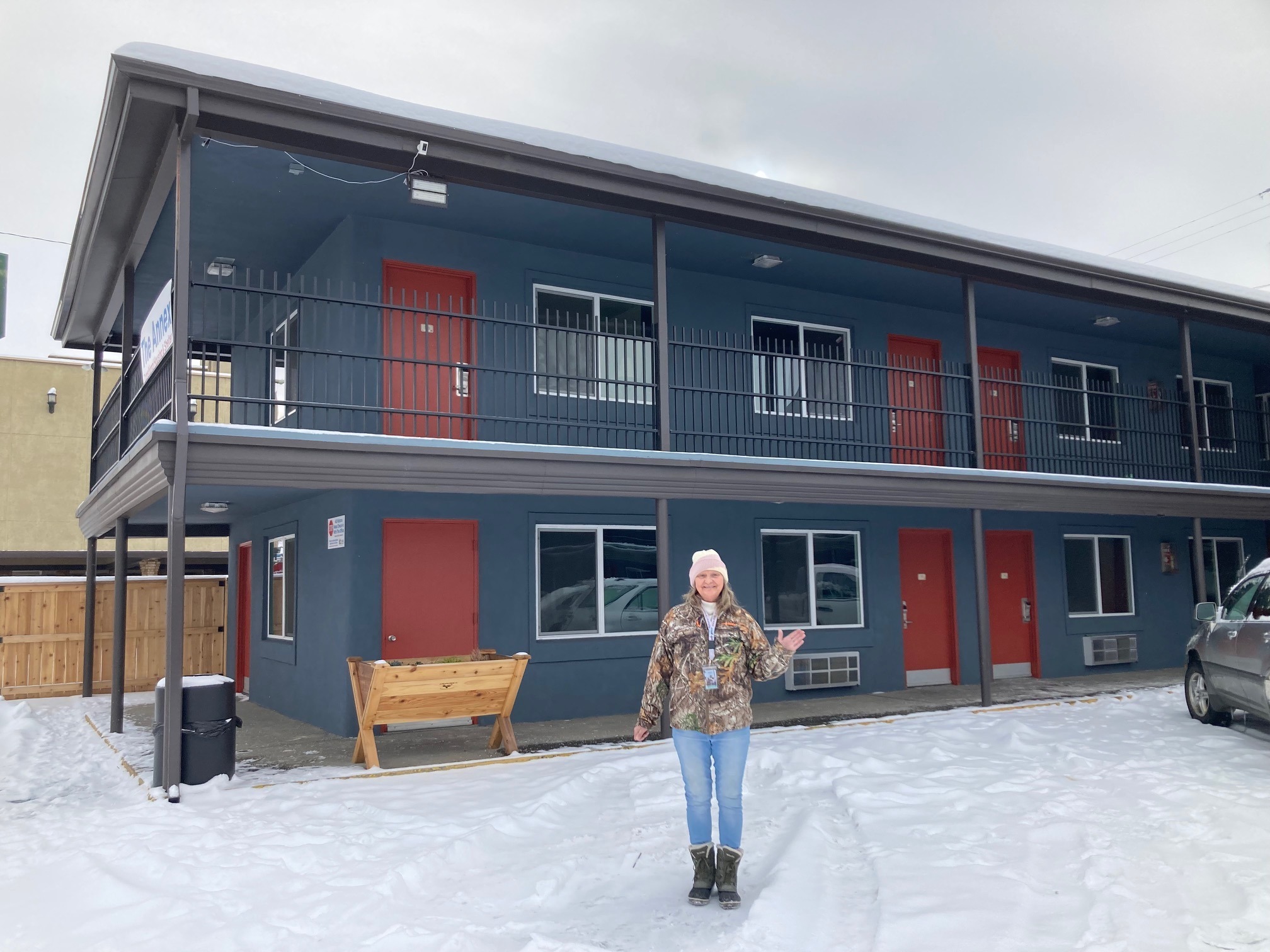How one state is tackling homelessness by turning abandoned buildings into shelters
Nina Jarl never thought she would be homeless.
But as housing grew increasingly unaffordable in Oregon, Jarl, 63, said a series of unfortunate events left her sleeping in her car on the street in the cold weather.
"I raised four kids here by myself and always had a home and work and we made do," Jarl told ABC News. "So for me not to be able to afford me, by myself, is just crazy."
A stroke and a leg injury made it hard for Jarl to work, and when she couldn't pay rent, she was kicked out of the trailer she was renting, she said -- it "just all came and hit me at once."
"It's scary, very scary. I slept in my car, out by the bridge and I'd wake up, and there'd be all types of people staring in," said Jarl, who said she was "too proud to ask for help for a while."
When she went to the doctor's office for medical assistance for her leg, and they learned of her situation, they directed her to an abandoned hotel-turned-housing, one of the 32 renovated shelters created on underutilized properties in the state, Jarl said.
At the Annex in The Dalles, where Jarl is staying, she can live for up to a year with resources intended to help get her back on her feet. This includes a case manager to help get her into permanent housing by the end of her stay, according to Kenny LaPointe, executive director of the Mid-Columbia Community Action Council, which runs the Annex.
"If you're just providing emergency overnight shelter, you cannot connect people to the resources they need to get out of homelessness," LaPointe said. "Our goal and our agency is to end homelessness for each individual and family that comes into our system."
The Annex is one result of Project Turnkey, a state-funded initiative that has invested millions of dollars in local organizations to renovate abandoned buildings into shelters and manage them in order to address the surge in the unhoused population.
The project was "born out of crisis" amid the pandemic and devastating wildfires in the state in recent years, Megan Loeb, Oregon Community Foundation program officer, who led the administration of Project Turnkey.
The project has created properties in 27 cities in Oregon, adding more than 1,300 beds to the state's shelter system, according to Loeb. Though the project initially began in 2020, Loeb said a second wave of grants was given out to organizations in 2022 and 2023, with several properties still being built or renovated.
An initial analysis of the project's impact by the Oregon Housing & Community Services in 2021 found these properties were "navigating people to permanent housing at higher rates than any other shelter type in the state," Loeb said. For example, one shelter operated by Providence Health & Services and Yamhill Community Action Partnership moved nearly three in four guests directly into permanent housing, the analysis found.
Jimmy Jones, who runs an emergency shelter that offers on-site services and support, said his inn has had a 52% success rate in moving residents to permanent housing.
"I've gone from being a great skeptic to a convert that this is a way we can we can make a dent in the problem," Jones told ABC News.

Loeb said she hopes the project can be an inspiration for other states or cities dealing with issues of homelessness.
The shelters "honor the individual needs of a person who has been through trauma by giving them their own space, a door that locks, a place to keep their things, but also [be able to] seek the services that they need to decompress and to think about their next step to move into permanent housing," Loeb said.
Homelessness has continued to increase nationwide since 2016, with a dip in 2021 amid COVID-era housing and financial assistance policies. A recent report from the Department of Housing and Urban Development found more than 650,000 people were experiencing homelessness on a single night in January 2023, a 12% increase from 2022.
Oregon saw a 22.5% increase in homelessness during the height of the COVID-19 pandemic from 2020 to 2022, according to the HUD report. The state had the second-highest population of unsheltered homeless residents in 2023, with 65% of homeless people living outdoors, according to the report.
California saw a 6.2% increase from 2020 to 2022, Louisiana saw a 132.4% increase, Tennessee saw a 45.6% increase, and Arizona saw a 23% increase, according to the HUD.
Other states saw drops -- including New York, Texas, Massachusetts, Florida and the District of Columbia.
Residents in Oregon are increasingly burdened by renting costs -- with 80% of extremely low-income households paying more than half of their income for housing, according to an analysis of U.S. Census data from the housing advocacy nonprofit National Low Income Housing Coalition.
This follows the national trend: "In 2022, a record-high 22.4 million renter households spent more than 30% of their income on rent and utilities," according to a new study from the Joint Center for Housing Studies at Harvard University.
Despite the growing need in Oregon to address homelessness, this kind of project does not come without challenges, program organizers said.
Garnering public support for the projects before they are built has proved to be the most commonly cited roadblock for program organizers interviewed by ABC News.
The National Alliance to End Homelessness said community engagement was a barrier, and that the process's quick-moving pace led to concerns and opposition from community members.
Project Turnkey also stoked a heated debate among legislators in an October 2020 vote by the state’s Joint Legislative Emergency Board. According to local outlet The Center Square, some legislators argued the project would spend emergency funds too quickly, while others argued that holding off on addressing the homelessness crisis would cost the state more in the long run.
The project in total has granted more than $120 million to community organizations to renovate and run these shelters. These shelters also take ongoing investments to provide the services necessary to transition people to permanent housing, according to organizers.
Without stable housing or supportive programs, residents experiencing homelessness "cycle in and out of emergency departments, inpatient hospital stays, psychiatric centers, detoxification programs and jails," which results in high public costs, according to the National Alliance to End Homelessness.
Ongoing funding for the operations costs of these facilities will be vital to the program's success, according to Jones.
His housing program is staffed 24/7 for operations and security purposes, he said, and also offers regular case management services, health plan and food stamps enrollment, jail diversion and employment programs, and more.
"Ours is very well funded, but many of them are not," Jones said. "So that's been, I think, part of the bigger concern."
For Jarl, she said she's looking forward to the life ahead of her.
"There are people here that have gotten jobs and gotten places and moved out. And that's just wonderful. I love seeing that happen," she said.
She said she's been working with case managers at her facility to plan her next steps.
"We do a list of what we're gonna accomplish for the week, and things like that. So we're not just getting a free ride. We are expected to do our work and that's good," she said.
Jarl asked that people have compassion for homeless residents such as herself.
"They're your grandma, your grandfather, your mom -- so many different people," she said. "It just happens to you before you know it."



